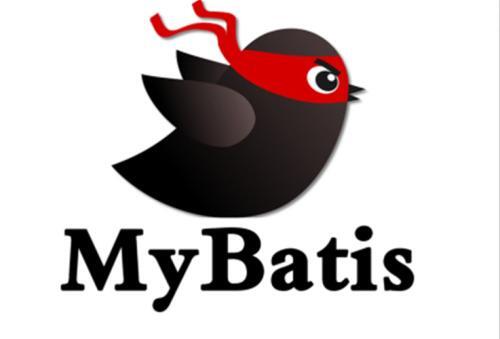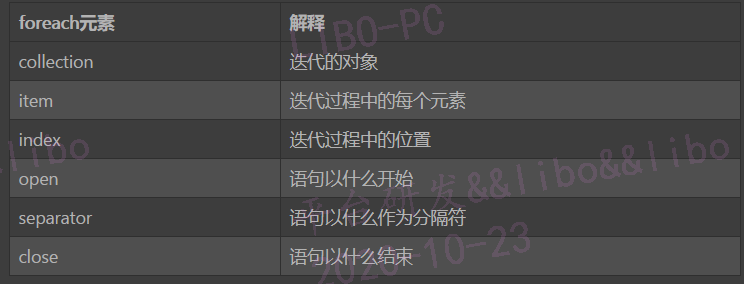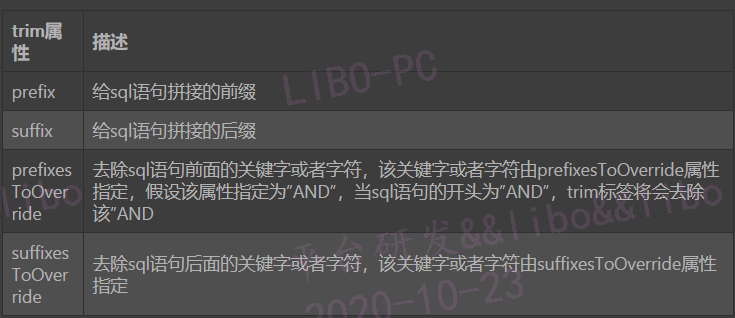在讲 MyBatis 动态 SQL 之前,先教大家怎么通过 MyBatis 插件自动生成 mapper 对应的文件和对应的 bean 文件。使用起来非常简单。
第一步,在 pom.xml 文件里面添加 plugin。这里要注意 configurationFile 部分这个字段指明 generatorConfig.xml 文件的位置。generatorConfig.xml 在第二步会教大家怎么配置。这里我们指定的目录是 resources/generator 文件夹下面,大家根据自己的实际情况来指定。
<plugin> <groupId>org.mybatis.generator</groupId> <artifactId>mybatis-generator-maven-plugin</artifactId> <version>1.3.2</version> <dependencies> <dependency> <groupId>mysql</groupId> <artifactId>mysql-connector-java</artifactId> <version>5.1.35</version> </dependency> </dependencies> <configuration> <!--配置文件的路径--> <configurationFile>${basedir}/src/main/resources/generatorConfig.xml</configurationFile> <overwrite>true</overwrite> </configuration> </plugin>
复制代码
第二步,generatorConfig.xml 文件的配置,主要改的地方就是 jdbcConnection 字段里面数据库相关的信息。以及 javaModelGenerator,sqlMapGenerator,javaClientGenerator 字段目标文件的位置。和 table 字段里面改成自己的表格。关于这些东西 generatorConfig.xml 文件里面咱们也注释的很清楚。
<?xml version="1.0" encoding="UTF-8"?><!DOCTYPE generatorConfiguration PUBLIC "-//mybatis.org//DTD MyBatis Generator Configuration 1.0//EN" "http://mybatis.org/dtd/mybatis-generator-config_1_0.dtd"><generatorConfiguration> <!--执行命令 mvn mybatis-generator:generate--> <context id="test" targetRuntime="MyBatis3"> <plugin type="org.mybatis.generator.plugins.EqualsHashCodePlugin"></plugin> <plugin type="org.mybatis.generator.plugins.SerializablePlugin"></plugin> <plugin type="org.mybatis.generator.plugins.ToStringPlugin"></plugin> <commentGenerator> <!-- 这个元素用来去除指定生成的注释中是否包含生成的日期 false:表示保护 --> <!-- 如果生成日期,会造成即使修改一个字段,整个实体类所有属性都会发生变化,不利于版本控制,所以设置为true --> <property name="suppressDate" value="true"/> <!-- 是否去除自动生成的注释 true:是 : false:否 --> <property name="suppressAllComments" value="false"/> </commentGenerator> <!--数据库链接URL,用户名、密码 --> <jdbcConnection driverClass="com.mysql.jdbc.Driver" connectionURL="jdbc:mysql://192.168.13.98/dcim" userId="root" password="123456"> </jdbcConnection> <javaTypeResolver> <!-- This property is used to specify whether MyBatis Generator should force the use of java.math.BigDecimal for DECIMAL and NUMERIC fields, --> <property name="forceBigDecimals" value="false"/> </javaTypeResolver> <!-- 生成模型的包名和位置 --> <javaModelGenerator targetPackage="com.pilot.dcim.alarmmanage.entity.model" targetProject="src/main/java"> <property name="enableSubPackages" value="true"/> <property name="trimStrings" value="true"/> </javaModelGenerator> <!-- 生成映射文件的包名和位置 --> <sqlMapGenerator targetPackage="com.pilot.dcim.alarmmanage.mapper" targetProject="src/main/resources"> <property name="enableSubPackages" value="true"/> </sqlMapGenerator> <!-- 生成DAO的包名和位置 --> <javaClientGenerator type="XMLMAPPER" targetPackage="com.pilot.dcim.alarmmanage.mapper" implementationPackage="com.pilot.dcim.alarmmanage.service.impl" targetProject="src/main/java"> <property name="enableSubPackages" value="true"/> </javaClientGenerator>
<!-- 要生成哪些表 --> <table tableName="alarmgroup" domainObjectName="AlarmGroup" enableCountByExample="false" enableUpdateByExample="false" enableDeleteByExample="false" enableSelectByExample="false" selectByExampleQueryId="false"></table> <table tableName="alarmparam" domainObjectName="AlarmParam" enableCountByExample="false" enableUpdateByExample="false" enableDeleteByExample="false" enableSelectByExample="false" selectByExampleQueryId="false"></table> <table tableName="alarmsetting" domainObjectName="AlarmSetting" enableCountByExample="false" enableUpdateByExample="false" enableDeleteByExample="false" enableSelectByExample="false" selectByExampleQueryId="false"></table> <table tableName="faultevent" domainObjectName="FaultEvent" enableCountByExample="false" enableUpdateByExample="false" enableDeleteByExample="false" enableSelectByExample="false" selectByExampleQueryId="false"></table> </context> </generatorConfiguration>
复制代码
第三步,上面两部都配置好之后,执行命令 mvn mybatis-generator:generate 就会在对应的目录下生成我们想要的文件。
MyBatis 的动态 SQL 是基于 OGNL 的表达式的。它对 SQL 语句进行灵活的操作。通过表达式判断来实现对 SQL 的灵活拼接、组装。我们着重讲说 MyBatis 动态 SQL 里面一些元素的使用。
一、MyBatis 动态 SQL 标签的学习
1.1、if 条件判断标签
if 标签通用用于通过判断参数值来决定是否使用某个查询条件。
1.1.1、if 判断数字
if 判断数字,大部分都是判断等于或者不等于某个数字。
<if test="filter == 1"> ...</if>
复制代码
1.1.2、if 判断字符串
大部分情况下都是去判断传递过来的字符串是否为空。当然咱们也是可以添加别的条件限制的,比如以啥字符串开头,以啥字符串结尾。
1.1.2.1、判断字符串是否为空,或者字符串等于某个值
<select id="selectUser" resultType="com.tuacy.mybatisdemo.model.User"> select * from user <where> <if test="user.name != null and user.name == '0'.toString()"> and name = #{user.name} </if> </where> </select>
复制代码
1.1.2.2、判断字符串是否包含
<select id="selectUser" resultType="com.tuacy.mybatisdemo.model.User"> select * from user <where> <if test=" user.name != null and user.name.contains('1'.toString())"> and name = #{user.name} </if> </where> </select>
复制代码
1.1.2.3、判断是否以字符串开头
<select id="selectUser" resultType="com.tuacy.mybatisdemo.model.User"> select * from user <where> <if test=" user.name != null and user.name.startsWith('1'.toString())"> and name = #{user.name} </if> </where> </select>
复制代码
1.1.3、判断列表
经常判断列表是否为 null,或者列表是否为空。列表判断也是很简单的直接 <if test=" nameList != null and nameList.size() > 0 "> 就搞定了。
一个简单的实例,通过用户名(list)查询用户
List<User> selectUserByName(@Param("nameList") List<String> nameList);
复制代码
<!-- 通过用户名查找用户 --> <select id="selectUserByName" resultType="com.tuacy.mybatisdemo.model.User"> select * from user <where> <if test=" nameList != null and nameList.size() > 0 "> <trim prefix=" name in "> <foreach collection="nameList" item="i" index="index" open="(" separator="," close=")"> <if test="i != null"> #{i} </if> </foreach> </trim> </if> </where> </select>
复制代码
1.2、choose,when,otherwise 标签(switch case)
choose,when,otherwise 标签的作用类似与咱们 java 里面的 switch case 的作用。
<choose> <when test="item.name != null"> #{item.name,jdbcType=VARCHAR}, </when> <otherwise> null, </otherwise></choose>
复制代码
1.3、foreach 循环标签
foreach 的主要用在构建 in 条件中,可以在 SQL 语句中进行迭代一个集合。大部分是对 list 进行循环。
foreach 元素的属性主要有 item,index,collection,open,separator,close。
在使用 foreach 的时候最关键的也是最容易出错的就是 collection 属性,该属性是必须指定的,但是在不同情况 下,该属性的值是不一样的,主要有一下 3 种情况:
如果传入的是单参数且参数类型是一个 List 的时候,collection 属性值为 list。
如果传入的是单参数且参数类型是一个 array 数组的时候,collection 的属性值为 array。
如果传入的参数是多个的时候,我们就需要把它们封装成一个 Map 了,当然单参数也可以。
<select id="dynamicForeachTest" parameterType="java.util.List" resultType="Blog"> select * from t_blog where id in <foreach collection="list" index="index" item="item" open="(" separator="," close=")"> #{item} </foreach> </select>
复制代码
array
<select id="dynamicForeach2Test" parameterType="java.util.ArrayList" resultType="Blog"> select * from t_blog where id in <foreach collection="array" index="index" item="item" open="(" separator="," close=")"> #{item} </foreach></select>
复制代码
map
<select id="dynamicForeach3Test" parameterType="java.util.HashMap" resultType="Blog"> select * from t_blog where title like "%"#{title}"%" and id in <foreach collection="ids" index="index" item="item" open="(" separator="," close=")"> #{item} </foreach> </select>
复制代码
上面说的都是没有指定 @Param 的情况,如果指定了 @Param 则 collection 的属性值是 @Param 指定的名字。
1.4、trim 标签
trim 标记是一个格式化的标记,可以完成 set 或者是 where 标记的功能。
<trim prefix="WHERE" prefixOverrides="AND"> <if test="state != null"> state = #{state} </if> <if test="title != null"> AND title like #{title} </if> <if test="author != null and author.name != null"> AND author_name like #{author.name} </if></trim>
复制代码
1.5、where 标签
where 标签是非常有用的,他有两个作用:
<!-- 查找指定的用户 --><select id="selectUser" resultType="com.tuacy.mybatisdemo.model.User"> select * from user <where> <if test="user.pkid != null"> pkid = #{user.pkid} </if> <if test="user.name != null"> and name = #{user.name} </if> <if test="user.phone != null"> and phone = #{user.phone} </if> <if test="user.password != null"> and password = #{user.password} </if> </where></select>
复制代码
1.6、set 标签
set 标签和 where 标签一样。会自动加上 set 关键字,并且去掉不必要的一些字符。
<set> <if test="userId !=null and userId !=''"> A.userId = #{userId,jdbcType=CHAR}, </if> <if test="userName !=null and userName !=''"> A.userName = #{userName,jdbcType=CHAR} </if> </set>
复制代码
1.7、bind 标签
bind 标签可以使用 OGNL 表达式创建一个变量井将其绑定到上下文中。咱就可以简单的认为是声明了一个变量。
这个例子里面,我纯粹的是把 user.name 替换成了 user.name 了。
<select id="selectUser" resultType="com.tuacy.mybatisdemo.model.User"> select * from user <where> <bind name="userName" value="user.name"/> <if test=" userName != null "> and name = #{userName} </if> </where> </select>
复制代码
这例子里面咱用 bind 标签声明了一个模糊查询的变量
<select id="selectUser" resultType="com.tuacy.mybatisdemo.model.User"> select * from user <where> <bind name="patternName" value="'%' + user.name + '%'" /> <if test=" user.name != null "> and name like #{patternName} </if> </where> </select>
复制代码
二、MyBatis 动态 SQL 实例
最后我们根据今天所学到的内容,给出两个比较复杂的 MyBats 动态 SQL。
2.1、批量插入并且更新主键
<!-- 批量插入并且更新主键 --> <insert id="insertUserBatch" parameterType="java.util.List" useGeneratedKeys="true" keyProperty="pkid"> insert into user (name, password, phone) values <foreach collection="list" item="item" index="index" separator=","> <trim prefix="(" suffix=")" suffixOverrides=","> <choose> <when test="item.name != null"> #{item.name,jdbcType=VARCHAR}, </when> <otherwise> null, </otherwise> </choose> <choose> <when test="item.password != null"> #{item.password,jdbcType=VARCHAR}, </when> <otherwise> null, </otherwise> </choose> <choose> <when test="item.phone != null"> #{item.phone,jdbcType=VARCHAR}, </when> <otherwise> null, </otherwise> </choose> </trim> </foreach> </insert>
复制代码
2.2、批量更新
<!-- 批量更新 --> <update id="updateUserBatch" parameterType="java.util.List"> update user <trim prefix="set" suffixOverrides=","> <trim prefix="name =case" suffix="end,"> <foreach collection="list" item="i" index="index"> <if test="i.name!=null"> when pkid=#{i.pkid} then #{i.name} </if> </foreach> </trim> <trim prefix=" password =case" suffix="end,"> <foreach collection="list" item="i" index="index"> <if test="i.password!=null"> when pkid=#{i.pkid} then #{i.password} </if> </foreach> </trim> <trim prefix="phone =case" suffix="end,"> <foreach collection="list" item="i" index="index"> <if test="i.phone!=null"> when pkid=#{i.pkid} then #{i.phone} </if> </foreach> </trim> </trim> where <foreach collection="list" separator="or" item="i" index="index"> pkid=#{i.pkid} </foreach> </update>
复制代码















评论